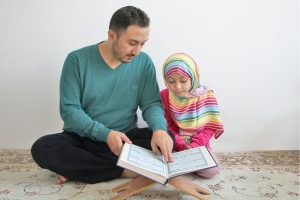Everybody tells the truth by his tongue, his action will be corrected and everybody has got good intention, his sustenance will be increased and everybody behaves well with his family, his lifetime will be long.
Muhammad Ibn ‘Ali al-Baqir (as)
Table of Contents
ToggleLearning Ahkaam Al-Huroof, the Arabic rules of pronunciation and recitation of Quran, is a journey that requires time and dedication. It involves mastering the articulation, properties, and pronunciation of the Arabic letters to accurately recite the holy Quran.
Basic Concepts and Principles
Foundational Concepts
Foundational Concepts are the building blocks upon which all other concepts and principles of learning are developed.
They form the basis of understanding and provide the fundamental knowledge that learners need in order to comprehend more complex ideas.
In the context of Ahkaam Al-Huroof, the study of Arabic letters and their rules, foundational concepts play a crucial role in laying the groundwork for learners to grasp the basic concepts and principles of this subject.
Ahkaam Al-Huroof is a fundamental aspect of Arabic language learning, as it deals with the rules and regulations concerning the pronunciation and writing of Arabic letters.
Without a solid understanding of foundational concepts, learners would struggle to comprehend and apply the basic concepts and principles of Ahkaam Al-Huroof effectively.
One example of a foundational concept in Ahkaam Al-Huroof is the recognition and identification of Arabic letters.
In order to learn the rules and principles of Ahkaam Al-Huroof, learners must first develop a familiarity with the Arabic alphabet.
This includes being able to recognize and differentiate between different letters, understand their shapes and sounds, and recognize their positions in words.
Without this foundational knowledge, learners would find it difficult to apply the rules and principles of Ahkaam Al-Huroof accurately.
Another foundational concept is the understanding of the basic phonetic sounds associated with each Arabic letter.
Each letter in Arabic corresponds to a specific sound, and being able to identify and produce these sounds correctly is essential for learning Ahkaam Al-Huroof.
For example, learners need to grasp concepts such as the difference between voiced and voiceless letters, correct pronunciation of letters with diacritical marks, and the rules governing the merging of certain sounds.
Without a solid understanding of these foundational concepts, learners may struggle to pronounce words correctly, leading to difficulties in applying the rules of Ahkaam Al-Huroof.
Comparison between different types of essays on Foundational Concepts as factors of Basic Concepts and Principles of learning Ahkaam Al-Huroof can be made in terms of structure and approach. The compare and contrast essay, for instance, would present the similarities and differences between two or more types of essays on this topic.
This would allow for a deeper analysis and understanding of the subject, enabling the reader to explore different perspectives and approaches to the topic.
On the other hand, a cause and effect essay could analyze the impact of foundational concepts on the comprehension and application of basic concepts and principles of Ahkaam Al-Huroof.
This type of essay would delve into the reasons behind the importance of foundational concepts and how they directly influence the learning process.
It would highlight the cause-effect relationship between a lack of foundational understanding and the difficulties learners may face in learning Ahkaam Al-Huroof effectively.
Ultimately, both types of essays serve the purpose of exploring the role of foundational concepts in the understanding and application of basic concepts and principles of learning Ahkaam Al-Huroof. They allow for a comprehensive examination of the topic, shedding light on the significance of foundational knowledge in laying the groundwork for successful learning outcomes.
Diverse Learning Materials
In the field of education, diverse learning materials play a significant role in enhancing students’ understanding of basic concepts and principles.
This is especially true in the context of learning Ahkaam Al-Huroof, which involves the foundational concepts and rules of Arabic grammar and phonetics.
By utilizing diverse learning materials, educators can cater to the diverse learning styles and preferences of their students, enabling them to grasp and master the complex concepts more effectively.
In this essay, we will explore how diverse learning materials align with the basic concepts and principles of learning Ahkaam Al-Huroof, and why this comparative approach is necessary for students’ success.
The foundational concepts of learning Ahkaam Al-Huroof emphasize the importance of comprehension and application.
These concepts are rooted in the understanding that each student has their own unique way of learning.
By presenting the material in diverse formats, educators can accommodate various learning styles and preferences, enabling students to internalize and apply the rules effectively.
For instance, some students may be visual learners who benefit from diagrams and visual aids, while others may be kinesthetic learners who prefer hands-on activities.
By offering diverse learning materials such as visual charts, interactive quizzes, and practical exercises, educators ensure that students are comprehending and applying the concepts of Ahkaam Al-Huroof in the way that best suits their learning style.
Furthermore, diverse learning materials promote student engagement and motivation. By incorporating multimedia resources such as videos, podcasts, and online platforms, educators can capture students’ attention and make the learning process more engaging.
This is particularly crucial in the context of learning Ahkaam Al-Huroof, a subject that can be perceived as challenging and intimidating.
By diversifying the learning materials, educators can create a more dynamic and interactive learning environment, making the subject more approachable and enjoyable for students.
Another key aspect of diverse learning materials is their ability to foster critical thinking and problem-solving skills.
In learning Ahkaam Al-Huroof, students are required to analyze and apply the rules in different contexts and scenarios.
By utilizing diverse materials such as case studies, real-life examples, and group discussions, educators encourage students to think critically and develop problem-solving strategies.
This comparative form of learning enables students to apply their knowledge of Ahkaam Al-Huroof to real-world situations, ensuring that they have a solid grasp of the underlying principles and concepts.
diverse learning materials are fundamental components of the basic concepts and principles of learning Ahkaam Al-Huroof.
By catering to diverse learning styles and preferences, educators can enhance students’ comprehension and application of the foundational concepts.
The use of diverse learning materials also promotes student engagement, motivation, and critical thinking skills.
With the introduction of multimedia resources and interactive activities, the learning environment becomes more inclusive and enjoyable for all students.
By adopting a comparative form of learning, educators ensure that each student has access to the necessary materials and resources to succeed in their journey of learning Ahkaam Al-Huroof.

Learning Resources and Materials
Textbooks and Workbooks
These resources play a crucial role in providing students with a structured and comprehensive approach to understanding the intricacies of Arabic phonetics and script.
While textbooks serve as the primary source of theoretical knowledge, workbooks enable students to apply and reinforce their learning through practical exercises.
In this essay, we will compare and contrast these two learning resources in terms of their features and effectiveness.
Textbooks are comprehensive guides that provide students with a systematic study of Ahkaam Al-Huroof.
They typically contain chapters that cover various aspects of Arabic letters, such as pronunciation, phonetic rules, and calligraphy.
These chapters are organized in a logical sequence, building upon previously covered material, to ensure a progressive and effective learning process for students.
Textbooks also include exercises and quizzes that help students assess their understanding of the theoretical concepts taught.
Moreover, they often include visual aids, such as diagrams and illustrations, to enhance the comprehension of complex topics.
Workbooks, on the other hand, are designed to complement textbooks by offering students the opportunity to practice what they have learned.
Workbooks contain a variety of exercises that enable students to apply their theoretical knowledge in a practical manner.
These exercises may involve writing practice, pronunciation drills, and identification of letter forms in various contexts.
By engaging in hands-on activities, students are encouraged to develop their skills and reinforce their understanding of Ahkaam Al-Huroof.
Additionally, workbooks often feature answer keys or model responses, allowing students to self-assess their progress and identify areas for improvement.
Both textbooks and workbooks have their own advantages and limitations when it comes to learning Ahkaam Al-Huroof.
Textbooks provide students with a comprehensive theoretical foundation, presenting them with a clear understanding of Arabic letters’ rules.
They offer explanations and examples to convey complex concepts effectively.
However, some students might find the theoretical nature of textbooks overwhelming or less engaging.
In contrast, workbooks provide a more interactive and practical approach, allowing students to actively apply their knowledge. The hands-on nature of workbooks can help reinforce learning and make it more enjoyable.
Nevertheless, workbooks might lack the complete theoretical coverage offered by textbooks, limiting the depth of understanding in certain areas.
In terms of effectiveness, a combination of using textbooks and workbooks proves to be most beneficial for students.
Textbooks provide the necessary theoretical knowledge, while workbooks offer opportunities for practical application.
By using both resources in tandem, students can benefit from comprehensive content coverage, practical learning, and self-assessment.
This combination allows for a balanced approach to learning Ahkaam Al-Huroof, catering to the diverse needs and learning preferences of students.
Online classes
Online classes like DarulQuran serve as excellent learning resources for Ahkaam Al-Huroof, the science of Quranic letters.
This descriptive essay will explore the various aspects of these online classes and highlight their significance in understanding the rules and nuances of Arabic letters in the noble Quran.
Ahkaam Al-Huroof is a branch of Quranic studies that focuses on the correct pronunciation, recitation, and understanding of the Arabic letters used in the sacred Quran.
It delves into the intricacies of Tajwid, the science of proper Quranic recitation, and provides learners with the rules and guidelines for pronouncing each letter accurately.
Online classes, such as those provided by DarulQuran, have become invaluable tools for individuals seeking to deepen their understanding of this fundamental aspect of Islam.
One of the key advantages of online classes like DarulQuran is the accessibility they offer.
These classes can be accessed from anywhere in the world, allowing learners to study at their own convenience.
Whether an individual resides in a rural village or a bustling city, access to quality educational resources is no longer limited by physical location.
This accessibility also enables students to take advantage of expert instruction without the need to travel long distances, saving time and resources.
Online classes provide an interactive learning environment. DarulQuran, for example, offers live classes where students have the opportunity to interact with knowledgeable instructors.
This interaction allows for real-time questions and clarification, enhancing the learning experience.
Additionally, online classes often incorporate multimedia resources, such as visual aids and audio recordings, to facilitate a comprehensive understanding of the subject matter.
This variety of instructional materials caters to different learning styles and ensures that students receive a well-rounded education.
Another significant aspect of online classes like DarulQuran is the opportunity for self-paced learning.
Traditional Quranic studies often involve strict timetables and limited flexibility, making it difficult for individuals with busy schedules to fully engage in the learning process.
Online classes, on the other hand, offer the flexibility of choosing one’s own study hours, allowing students to progress at their own pace.
This flexibility enables individuals to strike a balance between their personal commitments and their desire for religious education.
Moreover, the role of technology in online classes cannot be overstated.
DarulQuran utilizes advanced technologies, such as video conferencing and online discussion forums, to foster a sense of community among students.
Learners can engage in meaningful discussions with their peers, creating a supportive learning environment where knowledge is shared and ideas are exchanged.
The utilization of technology also ensures that classes can reach a wider audience, transcending geographical boundaries.
Online classes like DarulQuran serve as valuable learning resources for studying Ahkaam Al-Huroof, the science of Quranic letters.
Through their accessibility, interactivity, self-paced learning, and technological advancements, these classes provide individuals with the opportunity to delve deeply into the rules and nuances of Arabic letters in the sacred Quran.
As the world becomes increasingly interconnected through the internet, the significance of these online classes is only set to grow.
So if you are interested in mastering Ahkaam Al-Huroof, look no further than the online classes offered by DarulQuran.

Timeframe for Learning Ahkaam Al-Huroof
Focused Practice
Focused practice, as the term suggests, refers to a deliberate and concentrated effort to improve a particular skill or knowledge area.
In the context of learning Ahkaam Al-Huroof, focused practice involves dedicating consistent and uninterrupted time to study and understand the various rules and regulations.
This practice is essential to internalize and apply these rules effectively.
One of the primary reasons focused practice is significant is because it allows learners to break down complex concepts into manageable components.
Ahkaam Al-Huroof consists of numerous intricate rules and exceptions that need to be understood and memorized.
By concentrating on specific aspects or categories of these rules during practice sessions, learners can progressively master each element.
This focused approach ensures that learners develop a solid foundation before moving on to more advanced aspects of Ahkaam Al-Huroof.
Moreover, focused practice helps learners identify and correct their mistakes more effectively.
By devoting adequate time to practice specific Ahkaam Al-Huroof rules, learners can spot their weaknesses and areas of improvement more readily.
By repeatedly practicing these areas, they can address their shortcomings and enhance their understanding and application of Ahkaam Al-Huroof.
Focused practice also allows learners to receive immediate feedback and guidance from instructors, which further facilitates their learning process.
The timeframe for learning Ahkaam Al-Huroof can be shortened by incorporating focused practice into the learning routine.
Students who engage in regular, concentrated practice sessions are more likely to progress at a faster pace compared to those who rely solely on sporadic study sessions.
This intense focus enables learners to grasp complex rules quicker, retain information more effectively, and develop a deeper understanding of Ahkaam Al-Huroof.
However, it is essential to note that focused practice should be accompanied by a well-structured curriculum and guidance from proficient instructors.
Without proper guidance, learners may fall into the trap of practicing incorrectly or miss important aspects of Ahkaam Al-Huroof.
While focused practice is crucial, it should be supplemented with comprehensive learning materials, instructional support, and assessment mechanisms to ensure a holistic learning experience.

Consistent Review
Consistent review helps to counteract the natural process of forgetting. The Ebbinghaus forgetting curve, a psychological phenomenon, illustrates how information is rapidly forgotten unless it is reviewed and reinforced regularly.
By spacing out our review sessions and revisiting the Ahkaam Al-Huroof at frequent intervals, we actively combat the tendency to forget and actively reinforce our understanding of the rules.
Furthermore, consistent review enables us to identify and rectify any misconceptions or gaps in our understanding.
As we progress in our learning journey, we may encounter more complex rules or exceptions.
Regular review allows us to identify areas where we might be struggling or misunderstanding certain concepts.
By recognizing these gaps, we can seek clarification, ask questions, and deepen our understanding, thereby fortifying our foundation in Ahkaam Al-Huroof.
Consistency in reviewing also fosters active engagement with the material.
Merely memorizing the rules without consistent review can lead to surface-level understanding, hindering our ability to apply the knowledge optimally.
However, regular review prompts us to actively recall the information, check our comprehension, and connect the dots between different rules and their applications.
Through this cognitive process, a deeper understanding of the Ahkaam Al-Huroof is cultivated.
The timeframe for learning Ahkaam Al-Huroof may vary depending on individual aptitude and effort invested.
However, without consistent review, this mastery will likely be delayed or may never be fully achieved.
Just as with any skill or discipline, regular practice and review enhance our proficiency, reinforcing what we have learned, and solidifying our knowledge.
Tips for Effective Learning and Practice
Consistent Practice
To begin with, consistent practice helps learners in establishing a strong foundation in Ahkaam Al-Huroof.
Arabic grammar is a complex subject with numerous rules and exceptions.
Without consistent practice, learners might find it challenging to grasp and remember these rules.
Consistent practice enables learners to revisit and reinforce their understanding of various rules and their applications regularly.
As learners expose themselves to consistent practice, they start internalizing the rules, making them second nature.
This foundation becomes crucial in the advanced stages of learning Ahkaam Al-Huroof when learners encounter more complex grammatical concepts.
Moreover, consistent practice aids in the retention of knowledge. It is well-known that information retention is enhanced when learners engage with the subject matter frequently. The same principle applies to the learning and practice of Ahkaam Al-Huroof.
Consistent practice helps learners retain the rules and concepts learned for a more extended period. By practising consistently, learners continually reinforce their knowledge and strengthen their memory of the rules.
This way, they can effortlessly recall and apply the rules when needed, whether it is during written Arabic composition or interpreting classical Arabic texts.
Furthermore, consistent practice facilitates the mastery of Ahkaam Al-Huroof. It is essential to understand that mastering any subject requires time, effort, and regular practice.
Ahkaam Al-Huroof is no exception. Consistent practice allows learners to deepen their understanding, refine their skills, and gradually become proficient in applying the rules correctly.
Regular practice enables learners to internalize the rules and develop a natural sense of language structure.
This proficiency is indispensable when engaging in advanced Arabic grammar analysis or producing well-structured Arabic sentences.

Patient and Persistent
To embark on the journey of learning Ahkaam Al-Huroof, one must adopt a patient mindset.
This virtue is crucial as mastering the intricacies of pronouncing each Arabic letter requires time and consistent practice.
Understanding the various points of articulation and differentiating between similar sounds demands patience, as it may take repeated attempts before achieving the desired results.
For example, correctly pronouncing the Arabic letter “Ta’ ” requires the tongue to touch the upper gum ridge, producing a crisp sound. Initially, many learners struggle to achieve the correct pronunciation, but through patient practice and guidance from an experienced teacher, they gradually improve their skills.
Furthermore, patience is also required when faced with setbacks or difficulties. It is common to encounter challenges along the path of learning Ahkaam Al-Huroof.
Some learners may find some letters particularly challenging to pronounce, while others might struggle with maintaining correct pronunciation consistently.
In such situations, one must maintain a patient attitude, avoiding frustration or discouragement.
Instead, learners should approach these difficulties as opportunities to persevere and improve their skills.
Recognizing that mastery takes time and effort, patient learners continue to practice diligently, seeking improvement with every attempt.
Alongside patience, being persistent is another crucial factor in effective learning and practice of Ahkaam Al-Huroof. Consistency is key in reinforcing the correct pronunciation of each letter and maintaining a high standard of recitation.
Regular practice sessions ensure that learners maintain their progress and prevent regression.
Persistence motivates learners to dedicate a fixed amount of time each day to revise Ahkaam Al-Huroof and engage in practical recitation. This regular commitment and repetition enable the consolidation of knowledge and promote a deeper understanding of the intricacies of each letter.
By continuing to practice persistently, even when encountering challenges or feeling demotivated, students of Ahkaam Al-Huroof build a solid foundation for further learning and growth.
Moreover, persistence also helps learners to overcome the hurdles during the journey of mastering Ahkaam Al-Huroof.
It is not unusual for learners to face obstacles such as distractions, time constraints, or lack of motivation.
However, persistent learners remain dedicated to their goal, utilizing strategies to overcome these challenges.
They might establish a structured study schedule, engage in group study sessions with fellow learners, or seek guidance and motivation from knowledgeable teachers.
By actively seeking solutions to overcome challenges, persistent learners develop resilience and determination, enhancing their ability to navigate any obstacles that might stand in their way.
To sum up, patient and persistent learners are more likely to achieve effective learning and practice of Ahkaam Al-Huroof.
Through patience, learners approach their studies with a calm and determined attitude, understanding that mastery takes time and consistent effort. Similarly, persistence ensures regular practice and motivates learners to overcome obstacles and maintain progress.
By cultivating these virtues, one can embark on a meaningful journey of mastering Ahkaam Al-Huroof, connecting more deeply with the noble Quran, and attaining the desired level of proficiency in recitation.

















